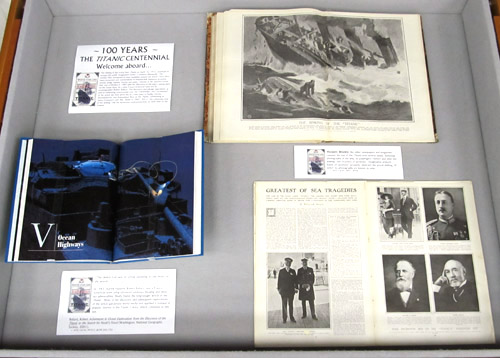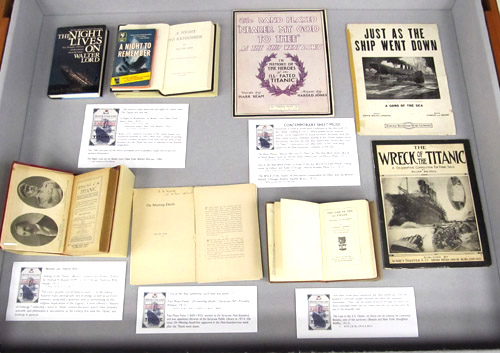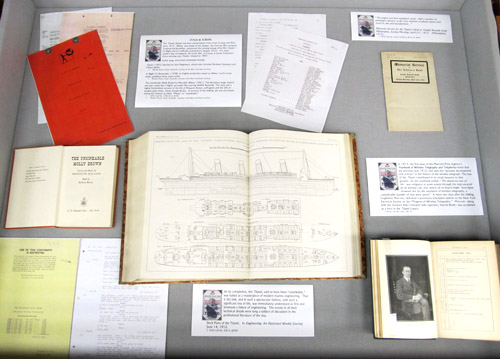April 2012
This exhibit was on display at the NYS Library during April 2012, in commoration of the 100th anniversary of the sinking of the ocean liner Titanic (April 15, 1912), an event that continues to occupy the public imagination today. The events—first trumpeted in news headlines around the world—have since been recounted and memorialized in innumerable historical accounts, novels, songs, poems, movies and plays. Interest in the doomed ocean liner was rekindled in 1985 with the discovery of the ship's resting place on the ocean floor, by a joint Franco-American team led by oceanographer Robert Ballard. The discovery and salvage operations, as well as continuing controversies over the "ownership" and "sacredness" of the wreck site have given rise to a new spate of books, articles, documentaries, and fictionalized films on the Titanic, culminating in James Cameron's epic film Titanic in 1997. 2012—the centennial year of the sinking—saw numerous commemorations on both sides of the Atlantic.

Harper's Weekly, like other newspapers and magazines, covered the loss of the Titanic over several issues, featuring photographs of the ship, its passengers—before and after the sinking—and the recovery of survivors. Imaginative artwork, based on survivors' accounts, depicted the actual sinking, of which no photographs are known to exist.
"The debris trail was an arrow pointing to the heart of the wreck..."
In 1985, marine explorer Robert Ballard, and a Franco-American team using advanced undersea imaging and deep-sea submersibles, finally found the long-sought wreck of the Titanic. News of the discovery and subsequent explorations of the wreck galvanized world media and sparked a renewal of popular interest in the Titanic's story, which continues to this day.
Adventures in Ocean Exploration: from the Discovery of the Titanic to the Search for Noah's Flood by Robert Ballard (Washington: National Geographic Society, 2001).
"Yet at the final summons, each man was alone…"
On Meeting Death by Paul Mayo Paine (Syracuse, NY: Privately Printed, 1912).
Paul Mayo Paine (1869-1955) worked at the Syracuse Post-Standard, and was appointed librarian of the Syracuse Public Library in 1915. His essay "On Meeting Death" first appeared in the Post-Standard one week after the Titanic went down.

"Women and children first!"
Sinking of the Titanic: World's Greatest Sea Disaster edited by Thomas H. Russell, A.M., Ll. D. (Chicago: National Bible House, 1912).
This early "graphic and thrilling account..." of the sinking featured many photographs and drawings, as well as survivors' memoirs, along with a generous dose of sermonizing on the religious implications of the tragedy. It even offered a "history of icebergs," reflecting a trend in Titanic-related literature, which often included scientific and philosophical speculations on the iceberg that sank the Titanic, and icebergs in general.
"This book is really about the last night of a small town. The Titanic was that big…"
A Night to Remember by Walter Lord (New York: Henry Holt, 1955).
(Paperback edition, New York: Bantam, 1955)
~Copy courtesy of a staff member
Walter Lord's masterful evocation of the Titanic disaster was a sensational bestseller in 1955. More than a simple recounting of events it evoked the spirit of the times and the sense of lost grandeur that the Titanic has come to represent in the popular imagination. The 1985 discovery of the wreck prompted Lord to publish a sequel full of new and updated information.
The Night Lives on by Walter Lord (New York: William Morrow, 1986).
~Copy courtesy of a staff member
"And then, as we gazed awestruck, she tilted slowly up…until she attained a vertically upright position; and there she remained—motionless!...Then…she slid slowly forwards through the water and dived slantingly down; the sea closed over her and we had seen the last of the beautiful ship."
The Loss of the S.S. Titanic: Its Story and its Lessons by Lawrence Beesley. (Boston and New York: Houghton Mifflin, 1912).
Contemporary Sheet Music: Hundreds of musical works were composed in the aftermath of the Titanic's sinking in 1912. Many played on the popular notion—never supported by actual survivors' accounts—that the ship's band bravely continued playing as the Titanic slipped below the surface, and that the tune they played was "Nearer My God To Thee." Controversy over what tune—if any—was being played in the final moments, continues to this day.
The Titanic disaster has been memorialized many times in plays and films since 1912. Within two weeks of the disaster, the German film company Contintental-Kunstfilm, announced the coming release of its film Titanic—In Night and Ice (officially premiered in August 1912). For most modern-day moviegoers, the iconic film, of course, is James Cameron's Oscar-winning epic, Titanic, released in 1997.

Earlier stage and screen treatments include:
"The largest and best equipped vessel…with a number of passengers aboard, at the very mention of whose names men stood in awe and wonderment…"
Memorial Service for the Titanic's Dead at Temple Kenesth Israel, Philadelphia, Sunday Morning, April 21st, 1912. (Philadelphia, 1912).
In 1913, the first issue of the Marconi Press Agency's Year-Book of Wireless Telegraphy and Telephony noted that the previous year, 1912, had seen the "greatest development and activity" in the history of the wireless telegraph. The loss of the Titanic contributed in no small measure to that growth. As the yearbook noted: "The disastrous loss of life...was mitigated to some extent through the help secured by its wireless call, and, where all on board might have been drowned but for the assistance of wireless telegraphy, a considerable number of lives were saved." A mere two days after the sinking, Guglielmo Marconi, delivered a previously-scheduled address to the New York Electrical Society on the "Progress of Wireless Telegraphy." Marconi—along with the doomed ship's intrepid radio operator, Harold Bride—was acclaimed as a hero in the Titanic's story.
At its completion, the Titanic, said to have been "unsinkable," was hailed as a masterpiece of modern marine engineering. That it did sink, and in such a spectacular fashion, with such a significant loss of life, was immediately understood as first and foremost a failure of engineering. The events in all their technical details were long a subject of discussion in the professional literature of the day.
"Deck Plans of the Titanic." Engineering: An Illustrated Weekly Journal, June 14, 1912.
Exhibit curated by Paul Mercer